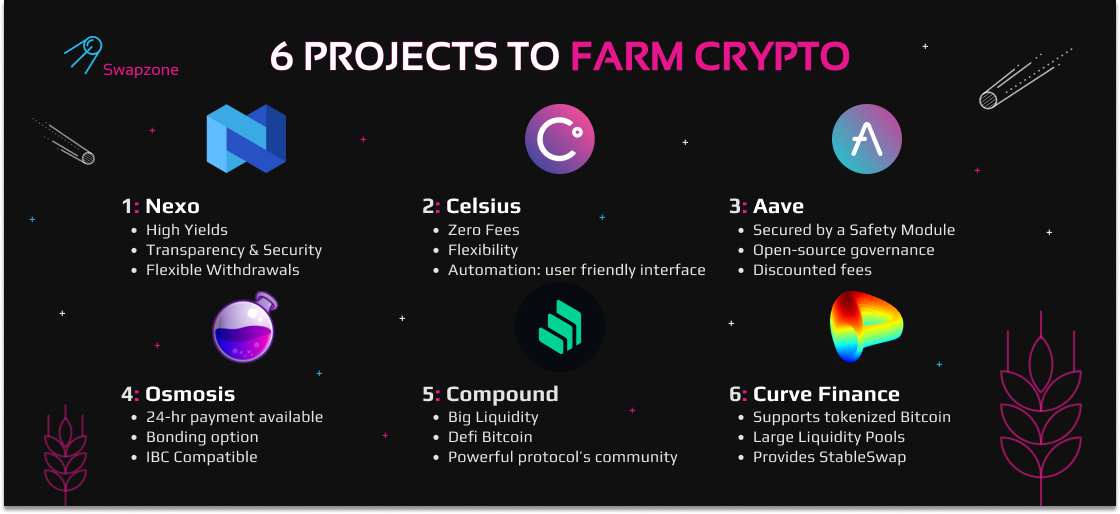Since 2009, when the first blockchain project came to life, several financial products developing from the resulting cryptocurrency craze have taken the finance world by storm. One of such schemes, originating from the DeFi world(another resulting blockchain technology product), is Yield Farming – a reward program for locked funds that equally costs unassuming beginners their precious capital and produces compounding wealth for savvy investors.
In this article, you will learn all about Yield Farming. Also, we would answer Yield Farming related questions such as what is Yield Farming, how to choose a good yield farm, and how does Yield Farming work.
What is Yield Farming?
Yield farming is a process that allows digital assets and cryptocurrency holders to deposit their holdings in a liquidity pool so they can earn interest or rewards on them. Interest earned on deposited assets could be variable or fixed depending on the different crypto farm offerings you choose to utilize.
In simpler terms, yield farming allows anyone to earn passive income by depositing digital funds on decentralized platforms. Despite some concerns, such as impermanent loss, Yield farming is one of the DeFi concepts that has continued to gain a lot of market attraction because of its high yield and sustainable structure.
How Does Yield Farming Work?
Yield farming requires users(often called Liquidity Providers) and a Liquidity pool(decentralized smart contracts containing pooled funds). Once this requirement is fulfilled, users can begin adding funds to the liquidity pools, which serve as, sources of exchange and lending to other users.
In return for depositing funds, users get rewards for contribution periodically, based on the underlying Defi protocol rules. To generate compounding interest on contribution, users can further reinvest rewarded tokens back into the liquidity pool to generate higher yields. Most importantly, note that rewards are determined by the amount deposited, so higher capital translates to higher rewards.
- Users deposit funds to a liquidity pool
- Your rewards or returns are based on the amount of your deposit. As well as the rules, and preset APY of the DEFI protocol you choose to use
- You can create compounding yields by reinvesting your reward into the same liquidity pool or choose to move it into another liquidity pool with a higher interest yield.
How To Choose A Good Yield Farm?
Yield farming remains a high-risk and high-reward endeavor that might be worth pursuing to interest-seeking investors. However, as long as the necessary research and due diligence are done, the upside could reward investors with compounding wealth.
Therefore, choosing the best yield farming will depend on how much capital you want to use, how long you plan to invest, and how much risk you are willing to take. You should also take into consideration, certain factors including; performance tracking, rate, ease of implementation, annual percentage yield (APY), short/long-term rewards, transaction/gas fees, Greater capital benefit availability, and impermanent loss policy.
Yield Farming Projects
To make it easier for you, we have compiled a list of crypto yield farming projects and platforms that performs adequately on all the above metrics for your easy perusal.
Nexo Crypto
Nexo was launched in 2018, and since then, has continually strived to bring professional financial services to the world of digital assets. Today, Nexo crypto Yield Farms manage assets for more than 3.5 million users and supports more than 40+ deposit farms. Nexo Crypto Yield Farming enables users to earn interest on a wide variety of cryptocurrencies including Bitcoin, Ethereum, EOS, stable coins, and more. Some of the benefits of using Nexo crypto for yield farming includes;
- High Yields: Users can earn up to 8% APR on cryptocurrencies and 12% APR on stablecoins
- Transparency: Users can monitor the performance of their assets in real-time using the Nexo reserves audit feature
- Security: All assets and liquidity provided to Nexo’s crypto yield farming are insured, with up to $375M insurance provided by top custodians
- Flexible Withdrawals: Users can withdraw their deposits at any time, although withdrawals are capped at five free crypto withdrawals per month.
Celsius Crypto
Launched in 2107, Celsius has become one of the leading crypto platforms that let users earn interest on their crypto savings. Today, the Celsius crypto farm has about $8.2 billion in total investment volume and offers between 2% to 18% as an average annual interest on its eclectic range of crypto financial products. Some of the unique benefits of choosing Celsius for Yield farming include:
- Automation: The Celsius crypto interface is user friendly and allows users to deposit funds into the liquidity pool in a few steps
- Zero Fees: Celsius does not charge fees for deposits or withdrawals. Also, Celsius offers some loans at 0% APR
- Flexibility: Celsius allows users to lend in 39 different currencies and allows these funds to be used however the user pleases. Users can swap out between cryptos at any time and can also reinvest in the pool to compound their gains.
Aave
Starting as ETHLend in 2017, The Aave DeFi protocol is an open-source and non-custodial liquidity protocol for earning interest on deposits and borrowing assets. The Aave DeFi protocol went live on the Ethereum blockchain in 2020 and has amassed up to $18.5 billion in its liquidity protocol. Asides from Aave Yield Farming, the Aave DeFi protocol offers more DeFi services including ultra-short duration and uncollateralized flash loans, all of which reward users with Aave crypto tokens. Some of Aave’s Yield farming benefits include:
- Safety Module: Aave DeFi protocol and Yield Farming is secured by a Safety Module (SM), a staking mechanism for AAVE tokens to act as insurance against Shortfall Events. Users earn AAVE as Safety Incentives (SI) along with a percentage of protocol fees.
- Governance: The governance of the Aave crypto protocol is completely open-source, and all matters concerning the future of the protocol are determined through a vote on Aave Improvement Proposals(AIPs)
- Discounted fees: Users who deposit Aave DeFi tokens as collateral get a discount on fees. As well as an increased upper limit on loan amounts.
Osmosis
Founded by Sunny Agrawal and Josh Lee, Osmosis is a self-governing and Automated Market Maker protocol for the alternative IBC-compatible networks on the DeFi ecosystem. Osmosis allows its users to earn rewards on their Yield Farming with alternative and cross-chain coins like ATOM, XPRT, OSMO, ION, AKT, and more. In addition, Osmosis’ user interface is accessible to beginners, and its eclectic Yield Farming options present users with several choices of liquidity pools with different APYs to choose from. Some of Osmosis’ benefits include:
- 24-hr payment available: You will be earning rewards and APY interests in OSMO, the native token of the Osmosis ecosystem, and these rewards could be paid daily if you so wish.
- Bonding: Osmosis allows users the option to bond their LP tokens by locking them for a period of 24-hours, 7 days, or 14 days to earn higher APY.
- IBC Compatible: Osmosis is designed to be cross-chain and IBC compatible. In the future, developers plan to branch out, via Althea gravity bridge and custom pegs, to non-IBC enabled chains like Ethereum, Bitcoin, and other smart contract platforms.
Compound Crypto
Compound Crypto, launched in 2018, is an Ethereum based Defi protocol that allows users to pool funds together in a liquidity pool to earn interest. Currently, Compound crypto supplies about $10.2 billion in liquidity to the Defi markets and holds a loan portfolio of more than $3.6 billion. Users are rewarded with Compound’s native cToken. Some of Compound Yield Farming unique benefits include:
- Governance: The big decisions on the compound crypto protocol are taken by the protocol’s decentralized community.
- Big Liquidity: Users can be assured about the safety of their funds as the Compound crypto liquidity pool has one of the largest market capitalizations in the Defi Yield Farming space
- Defi Bitcoin: A unique aspect of Compound is its ability to integrate Bitcoin into the Defi environments. This is accomplished through the introductions of Wrapped Bitcoin (WBTC) which is an ERC-20 derivative of locked Bitcoin.
Curve Finance
Curve Finance, launched by Micheal Egorov, in 2020, is an Automated Market Maker protocol that allows users to exchange cryptocurrencies and earn rewards on locked funds. The total pool of funds in the curve finance protocol rises to almost $19 billion in deposits and records an average of $333.9 million daily transaction volume. The Curve finance site features a retro 90s display that lists all the yield curve finance liquidity pools available to users with their corresponding APYs, so users can easily browse and pick a choice. Some of Curve finance’s unique benefits include:
- Supports tokenized Bitcoins: Curve is one of the best Defi protocols in the market that allows users to swap and deposit different tokenized versions of Bitcoin, such as renBTC, sBTC, and WBTC.
- Large Liquidity Pools: According to Defi pulse, Curve finance liquidity pools are the second-largest Ethereum DEX, second only to widely-popular DEX, Uniswap.
- Provides StableSwap: Curve Finance is a fully autonomous market-maker for stable coins with minimal slippage. This means that it efficiently serves as flat savings account for users willing to deposit their funds in stablecoins without risk.
How Do You Exchange These Coins At The Best Rates?
Do you want to start earning passive income from Yield Farming crypto? Look no further, Swapzone is one of the best exchanges to buy ETH and other native ERC-20 protocol tokens of yield farms, in the market. Swapzone provides real-time swap offers and discounts. Here’s how to buy Yield farming crypto tokens or convert crypto to ETH coins:
- Visit the Swapzone website.
- Select the proper pair (BTC to the native token).
- Enter the amount of native token you want to exchange for BTC, and the aggregator will find the best offers available for you.
- Click the ‘Exchange’ button to go to an exchange platform
- Input the address where you want to send the native token coins.
- Send your money to the address you typed in.
- Go to ‘Proceed to Exchange’ and, if you want, leave a review of the website where you completed your exchange.
- Allow for the processing of the deposit and the completion of the native token exchange.
- Your coins should be in your wallet once the process completes.


